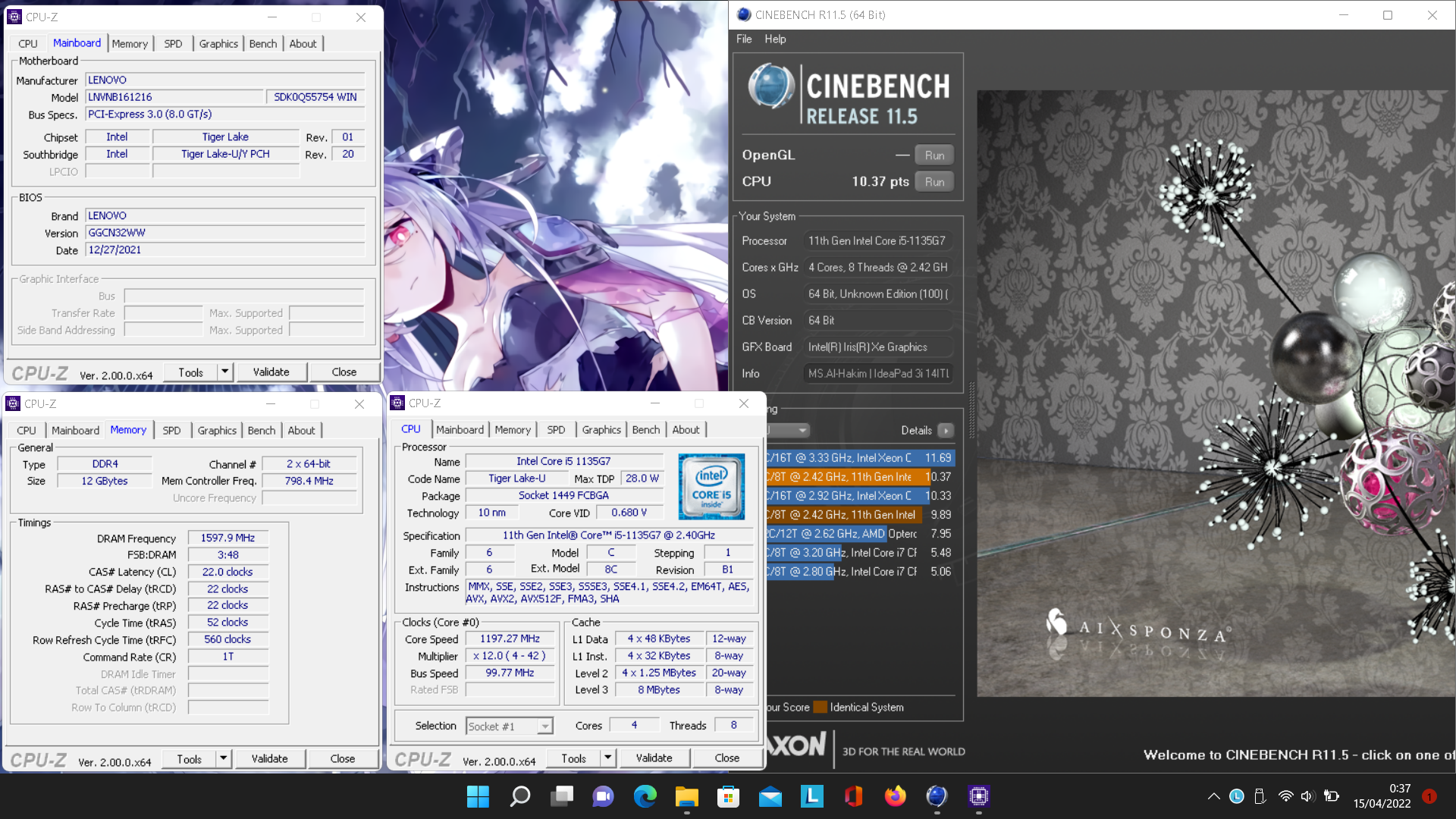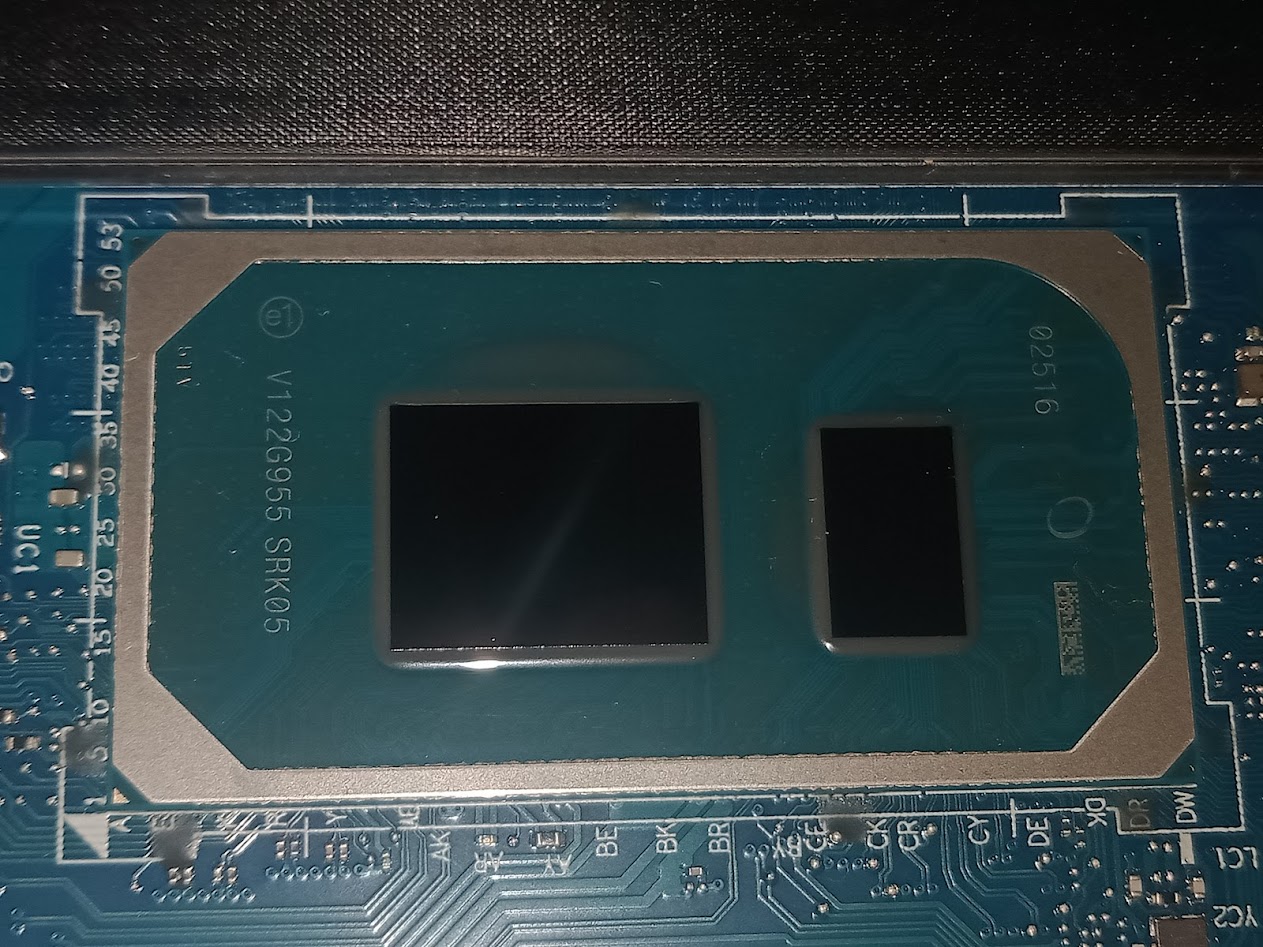Cinebench - R11.5 score 10.37 pts with a i5-1135G7
Thursday, 01 January 1970 07:00 | Update at null
Media Gallery
Screenshot

Device, Setup, etc



URL
https://hwbot.org/submission/4974594https://bit.ly/385KgZk
Information Detail
Hardware: Intel Core i5 1135G7
Specs:CPUID : 11th Gen Intel(R) Core(TM) i5-1135G7 @ 2.40GHz
Architecture : x86
Codename : Tiger Lake-U
L3 Cache : 8MB
Clock : 2.40GHz - 4.20GHz
Core/Thread : 4/8
TDP : 28W
Technology : 10nm
Socket : FCBGA1449
IGPU : Intel Iris Xe Graphics Mobile G7
See more specification...
Software: Cinebench - R11.5
Score: 10.37 pts
About: Cinebench - R11.5Cinebench R11.5 is one of MAXON's popular benchmarks designed to measure CPU performance in complex 3D rendering scenarios. The benchmark is based on the CINEMA 4D rendering engine and is widely used by tech enthusiasts, hardware reviewers, and professionals in the creative industry. Cinebench R11.5 simulates the rendering process of AixSponza's “No Keyframes” animation scene, which consists of thousands of 3D objects and various advanced lighting techniques and visual effects.
One of the key strengths of Cinebench R11.5 is its ability to use up to 64 processor threads in parallel, making it perfect for measuring the overall performance of multi-core CPUs. The test makes use of advanced algorithms such as sharp and blurry reflections, area lighting, realistic shadows, procedural shaders, and anti-aliasing, which represent real workloads in the 3D animation and visualization industry.
The scenes rendered in this benchmark include around 2,000 objects and over 300,000 polygons, making it very demanding for the test system. Test results are given in points (pts), where higher numbers indicate faster and more efficient CPU performance in completing rendering tasks. As such, Cinebench R11.5 is a very useful reference for assessing processor performance in creative and technical applications.
Despite the arrival of newer versions such as R15 and R23, Cinebench R11.5 is still relevant for users who want to make comparisons across processor generations. Many overclockers and users of legacy systems still rely on this version for stability and performance benchmarks due to its realistic yet not too heavy workloads for modern CPUs. With its ability to simulate real-world workflows, Cinebench R11.5 is a great test tool for anyone looking to evaluate their CPU performance in the context of professional rendering.
The Intel Core i5-1135G7 is a quad-core mobile processor introduced in late 2020 as part of Intel’s 11th generation Tiger Lake lineup. Designed for thin and light laptops, this CPU delivers a strong balance of performance, power efficiency, and modern features, making it a popular choice for both casual users and professionals. Featuring 4 cores and 8 threads through Hyper-Threading Technology, it operates at a base clock of 2.4 GHz and can reach up to 4.2 GHz with Intel Turbo Boost, ensuring smooth multitasking and snappy responsiveness for day-to-day applications.
Built using Intel’s advanced 10nm SuperFin process, the i5-1135G7 offers improved efficiency and thermal performance over previous 14nm generations. With a configurable TDP ranging from 12W to 28W, OEMs can adjust the performance envelope depending on the device’s thermal design. The standout feature of this processor is its integrated Intel Iris Xe Graphics, equipped with 80 Execution Units and a dynamic frequency of up to 1.3 GHz. Compared to older Intel UHD Graphics, Iris Xe brings a massive leap in performance, capable of handling casual gaming, 4K video playback, and GPU-accelerated workloads like video rendering or image editing.
In benchmark tests such as Cinebench R23, the i5-1135G7 scores around 5661 points (multi-core) and 1334 points (single-core), showcasing excellent performance for a low-power chip. These scores reflect its capability to handle modern productivity software, web-based workflows, and even creative tools like Adobe Photoshop or Premiere Pro though for heavier workloads, a higher-end CPU may still be recommended.
Real-world performance testing was done on a Lenovo IdeaPad Slim 3i 14ITL6, a budget-to-midrange laptop equipped with 12GB DDR4 3200MHz dual-channel memory (8+4 configuration). This setup, combined with Windows 10 and Windows 11 22H2, allows the i5-1135G7 to fully utilize its integrated GPU and high-speed memory interface for a snappy and responsive user experience.
Whether you're a student, a professional, or a casual user looking for a capable, energy-efficient processor, the Intel Core i5-1135G7 stands out as one of the best value choices in the ultrabook category.
Hardware Detail:
Device: Lenovo IdeaPad Slim 3i 14ITL6
RAM: 12GB DDR4 3200MHz Dual Channel (8+4)
OS: Windows 10, Windows 11 22H2
* Not Avaiable
